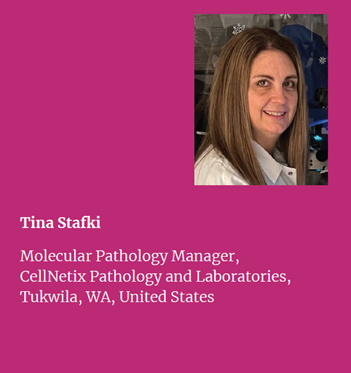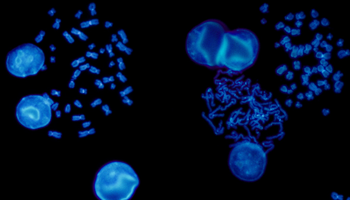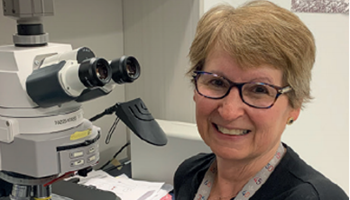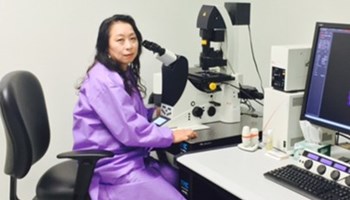 Pathology laboratories worldwide rely on cytogenetic technologies like fluorescence in situ hybridisation (FISH) to detect acquired genetic abnormalities implicated in different cancer types. In conjunction with other clinical information, these genetic aberrations may provide healthcare providers with insight into their patients’ diagnosis, prognosis, and therapeutic decisions. FISH is a powerful method that can help pathologists detect and visualise the spatial positions of specific genetic abnormalities. Its high sensitivity and specificity as well as the speed at which it can deliver results have established FISH as a go-to assay for a wide range of genetic diseases and disorders.
Pathology laboratories worldwide rely on cytogenetic technologies like fluorescence in situ hybridisation (FISH) to detect acquired genetic abnormalities implicated in different cancer types. In conjunction with other clinical information, these genetic aberrations may provide healthcare providers with insight into their patients’ diagnosis, prognosis, and therapeutic decisions. FISH is a powerful method that can help pathologists detect and visualise the spatial positions of specific genetic abnormalities. Its high sensitivity and specificity as well as the speed at which it can deliver results have established FISH as a go-to assay for a wide range of genetic diseases and disorders.
We spoke to Tina Stafki, Molecular Pathology Manager at CellNetix Pathology (Tukwila,Washington), about how she got hooked on FISH early on in her career, how she uses FISH in the CellNetix pathology lab to help patients and clinicians across the Pacific Northwest, and why CytoCell® FISH probes from OGT are her first choice when it comes to FISH probes.
I started in cytogenetics in 1990, which was very, very early on in the history of FISH. Some colleagues across the hall in an R&D lab were running rudimentary FISH testing - this was my first exposure to it.
After a period in research where I developed my own FISH probes, I returned to cytogenetics in 1998. At this point, we were running quite a few constitutional probes, and that was pretty exciting. But it wasn’t until I moved to a pathology lab (in Spokane) that I received in-depth FISH training. I ended up transferring almost full-time to the FISH department of the lab and worked my way up to lead.
Five years ago, I moved back to Seattle and started working at a major cancer center in the Cytogenetics Laboratory at Seattle Cancer Care Alliance (SCCA). Nine months later, I started my current role as the molecular pathology supervisor at CellNetix.
CellNetix is a pathology laboratory located just south of Seattle in Tukwila, Washington. It’s a state-of-the-art building and we’ve got a fairly large team of around 400. We also have several satellite sites that serve the various hospitals around the Seattle area, east of the mountains in Spokane and Alaska and also in the South Puget Sound region. I oversee the molecular testing at CellNetix including FISH, targeted PCR, and NGS assays as well as infectious disease.
Back in my research days, we had to grow our own BACs (bacterial artificial chromosomes) and YACs (yeast artificial chromosomes). It was a long and laborious process and the results were really, really ugly compared to nowadays! This was back in the day when we had to use a microscope, take pictures and make them into slides to put them on the slide carousel. It was the Neanderthal age of FISH!
I first started using CytoCell probes in the pathology lab in Spokane, and they were hands down our favourite probes. Whenever we ran an assay with the CytoCell probes, the FISH technicians were always happy because they had better signals, were easier to read and we felt more confident about the results that we were seeing.
When I started my current role at CellNetix, I was tasked with bringing FISH testing back on board. Because of my positive experience with CytoCell, I wanted to start to validate these probes. Validation is much easier than it used to be because CytoCell probes are manufactured under very specific conditions and OGT has strict QC parameters – so we don’t have to worry about quality issues.
In addition to making it easier to discern the signals and the quality indexes of CytoCell probes, we were also really excited about the customer service standpoint. Every person on all levels that I’ve contacted at OGT has been extremely attentive; they’re very quick to respond to my requests, always willing to help me understand the technology better, and they’re very forthcoming with any changes in the probes and in their design.
OGT’s team of Field Applications Scientists are also very knowledgeable and helpful, we felt very comfortable working with them.
We also love the website design. It’s clear, colourful, and informative. Just yesterday, for example, I was reading an article that was not only very informative, but the references helped me to delve deeper into the subject matter.
Being a pathology lab, we’ve always had a strong tissue FISH department with high volumes. But additionally, several years ago, I was also able to bring back heme FISH to CellNetix’s capabilities. Interpreting the complexities of heme FISH testing is difficult without robust cytogenetics training and there just wasn’t the expertise in the lab.
But with support from OGT, including modules from CytoCell University’s FISH training, we now routinely run haem FISH LDTs* with multiple CytoCell ASR† probes: including a panel of probes we have selected based on local requirements for exploring chronic lymphocytic leukaemia (CLL) and multiple myeloma (MM). These have been very successful and extremely well received. In fact, our CEO has often mentioned in various venues that she’s excited that we have haem FISH back at CellNetix.
There are pros and cons to both from the lab’s standpoint. We have certain clients that may prefer FDA-approved probes and there’s certain treatment modalities, where reimbursement is dependent upon having used FDA probes during the testing. Ensuring we get proper reimbursement in those cases is important.
The downside is, of course, that you have to use them on label which puts a lot of restrictions on us being able to tweak them slightly in a way that doesn’t impact quality, but may help our workflows be more efficient.
With regard to validating FDA versus ASR, we abide by our own internal validation standards. This generally means we validate them to the same level of consistency within our own system, regardless of whether they are FDA or ASR.
No, I think that FISH and NGS work in harmony. Being able to offer FISH alongside NGS provides us with good resolution on copy number gain and low level amplification which poses a problem in NGS. We’re also looking to onboard a number of probes that we have selected for acute myeloid leukaemia (AML) which will co-exist nicely with our myeloid NGS panel. FISH will give us a quick answer to the big questions – such as whether they have any of the typical, major translocations. The NGS results will follow a week or two later and this will enable us to give our clients a lot more in-depth information to help them fully charaterise what’s going on and guide further treatment decisions.
At CellNetix, we’re enthusiastic about embracing new technology and being open to new ideas. This means we’re in a good position to onboard new technology and expand our test menu to better serve our clients, our pathologists, the local hospitals and ultimately the patient community.
Yes, of course! I recommend OGT and CytoCell FISH probes every chance I get. The quality of the FISH probes is excellent and the customer service is second to none. This has a real impact on helping us meet the needs of our clients and their patients too – it has real world consequences.
* LDT: Laboratory-developed test
† ASR: Analyte specific reagent

FISH is a cytogenetic technique utilised in labs to detect chromosomal abnormalities in both cancer and constitutional specimens. In this blog learn about the advantages of FISH...
Read
Theresa Brown talks about how her lab’s FISH analysis benefited from using OGT's CytoCell® FISH probes in conjunction with STEMCELL Technologies’ EasySep™ Human CD138+ enrichment and automated cell isolation.
Read
Carmen Vokaty, Assistant-Chief Medical Technologist in Cytogenetics at the McGill University Health Centre, details how her lab incorporated OGT’s Cytocell® Tissue Pretreatment kit into its workflow after struggling with a homebrew solution.
Read
Dr Jennie Thurston, Director of Cytogenetics, Carolinas Pathology Group, Atrium Health, explains how OGT's CytoCell® FISH probes were seamlessly incorporated into the automated workflow for fast, high quality results.
Read
Dr. Theresa C. Brown, Tulane University School of Medicine, answer questions around her AGT 2017 presentation 'FISHing with the real-life laboratory experts.'
Read
Megumi Hada, PhD, Senior Research Scientist, RaISE, Prairie View, Texas A&M. answers our questions on space radiation, how it affects astronaut health, and what her research can teach us about the biological effects of radiation here on Earth.
Read